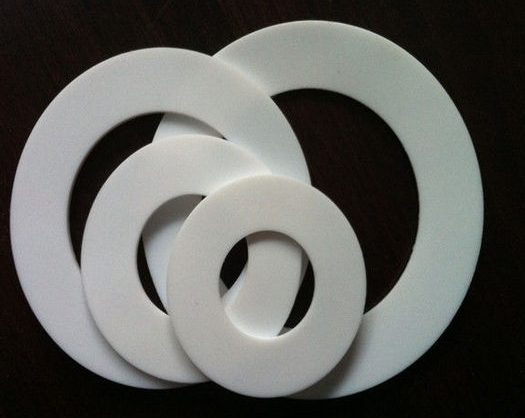- 13
- Nov
Guarnizione PTFE
Guarnizione PTFE
PTFE gaskets have excellent properties of creep resistance, cold flow resistance, ultra-low temperature resistance, no pollution, and easy installation and disassembly. Under a small pre-tightening force, it can withstand considerable internal pressure even in a pressure fluctuation environment. It is very suitable for rough or unevenly worn and fragile glass-faced flanges and temperature-changing sealing occasions. We can choose Gore, Klinger, Garlock, Sealon and other expanded PTFE sheets for customers to produce the required gaskets for customers.
vantaggio
Resistenza alle alte temperature: la temperatura di lavoro può raggiungere i 250 ℃.
Resistenza alle basse temperature: ha una buona tenacità meccanica; anche se la temperatura scende a -196 ℃, può mantenere un allungamento del 5%.
Resistenza alla corrosione: è inerte alla maggior parte dei prodotti chimici e dei solventi e può resistere ad acidi e alcali forti, acqua e vari solventi organici.
Weather resistance-has excellent aging life in plastics.
High lubrication-is the low coefficient of friction in solid materials.
Non-adhesion-it means that the surface tension in the solid material is small and does not adhere to any substance. Its mechanical properties have a very small friction coefficient, which is only 1/5 of that of polyethylene. This is an important feature of the perfluorocarbon surface. In addition, because the fluorine-carbon chain intermolecular forces are extremely low, PTFE is non-sticky.
Non-toxic and harmful-with physiological inertia, as an artificial blood vessel and organ implanted in the body for a long time without adverse reactions.
Proprietà elettriche Il politetrafluoroetilene ha una bassa costante dielettrica e una bassa perdita dielettrica in un’ampia gamma di frequenze e ha un’elevata tensione di rottura, resistività di volume e resistenza all’arco.
Radiation resistance Polytetrafluoroethylene has poor radiation resistance (104 rad), and it degrades after being exposed to high-energy radiation, and the electrical and mechanical properties of the polymer are significantly reduced. Application Polytetrafluoroethylene can be formed by compression or extrusion processing; it can also be made into water dispersion for coating, dipping or making fibers. PTFE is widely used as high and low temperature resistant, corrosion resistant materials, insulating materials, anti-stick coatings, etc. in nuclear energy, aerospace, electronics, electrical, chemical, machinery, instruments, meters, construction, textiles, food and other industries.
Resistenza all’invecchiamento atmosferico: resistenza alle radiazioni e bassa permeabilità: l’esposizione a lungo termine all’atmosfera, la superficie e le prestazioni rimangono invariate.
Incombustibilità: l’indice limite di ossigeno è inferiore a 90.
Resistenza agli acidi e agli alcali: insolubile in acidi forti, alcali forti e solventi organici.
Resistenza all’ossidazione: resistente alla corrosione da forti ossidanti.
Acidità: Neutra.
Le proprietà meccaniche del PTFE sono relativamente morbide. Ha un’energia superficiale molto bassa.
Polytetrafluoroethylene (F4, PTFE) has a series of excellent performance: high temperature resistance-long-term use temperature of 200~260 degrees, low temperature resistance-still soft at -100 degrees; corrosion resistance-resistance to aqua regia and all organic solvents; Weather resistance-aging life in plastics; high lubrication-with a small coefficient of friction (0.04) in plastics; non-stickiness-with low surface tension in solid materials without adhesion of any substances; non-toxic-with physiological inertness; excellent electrical properties , Is an ideal C-level insulating material.

